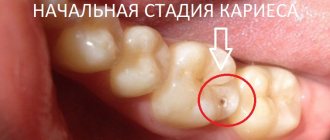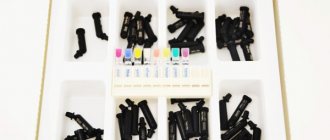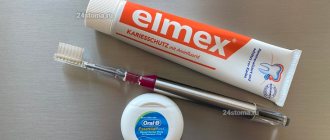According to statistics, caries occurs more often in children than in adults. This is one of the most common reasons for visiting a dentist, because not only permanent teeth, but also baby teeth are susceptible to destruction.
Children do not like to be treated, and often parents feel sorry for the child until the last moment and do not take him to the dentist in order to avoid stressful situations. But you need to understand that the health of his teeth in adulthood will depend on how they care for their baby’s oral cavity in childhood.
What are the causes of caries in children
The appearance of caries can be due to various reasons.
Insufficient or incorrect hygiene
Children most often do not want to brush their teeth - they are capricious because they do not like the process itself or the taste of the toothpaste. And parents often follow the lead and let the situation take its course, without insisting on the need for this procedure. However, it is necessary to teach a child to brush their teeth from a very early age, so that by the age of two the child himself shows a desire to take care of his teeth. Dentists recommend starting caries prevention immediately after the first teeth erupt.
Prolonged contact with the pacifier
In dentistry there is such a thing as “bottle caries”. It can develop before the age of 1 year, when the child is fed too long and often from a bottle with a nipple. Most often, such caries affects the upper front teeth, and the consequences are really serious.
Transmission of infection from parents
Many people are familiar with the situation when a child suddenly dropped a pacifier on the floor, the mother quickly picked it up, licked it and returned it to the baby. It's not as harmless as it might seem. This is how bacteria are transmitted that cause caries. For the same reason, you should not lick the baby's spoon when feeding. The infection can be transmitted even through kissing, so parents and other relatives who are in close contact with the child should carefully monitor the health of their teeth.
Congenital problems
Often, dental problems are congenital in nature. This may be genetic or caused by health problems in the mother during pregnancy. Bad habits, past illnesses, deficiency of vitamins and minerals (especially calcium) - all this affects the dental health of the unborn baby.
Abuse of sweets and carbohydrate foods
This is the most common cause of dental caries. Too much love for sweets is not good for children's teeth. Sweets, juices, lemonades, buns and cookies - all this creates a favorable environment for the development of bacteria and subsequent destruction of enamel.
Lack or excess of fluoride
Fluoride is necessary for the normal formation of teeth and to protect them from damage. We get it from food and water, and it is better to periodically get tested for the content of this element in the body in order to adjust nutrition and care in a timely manner. Both deficiency and excessive amounts of fluoride provoke dental problems.
Not early, but just right
The foundation for a child’s future dental health can be laid already in the perinatal period. It is important that the mother takes a balanced multivitamin during pregnancy. This will definitely help the formation of teeth rudiments in the baby. It is also important for the expectant mother to take care of her own health: prevent diseases, eat right, avoiding sweets and refined foods, and take medications only as prescribed by the doctor. The fact is that a number of drugs have a negative effect on the formation of teeth, as a result they can begin to erupt with defects, stains on the enamel of a darker color (for example, “tetracycline teeth”).
Babies develop their first teeth by the age of one year. However, some babies become toothies even earlier, at 4 months. The enamel layer of the first teeth is thin, the dental and gum tissue is loose, and there are a lot of blood vessels in it. Therefore, the process of teething often becomes extremely painful for children (and unforgettable for parents). To relieve pain, it is recommended to use children's pain-relieving gels and anti-inflammatory drugs, and for hygiene, use special brushes that fit on an adult's finger and special 0+ toothpastes.
Teeth are cutting. What problems await parents Read more
What are the stages of dental caries in children?
Tooth decay begins gradually, and with regular examination, parents and the dentist can catch the right moment in time and begin treatment.
| Initial stage Specks appear on the enamel, which differ in color from the rest of the tooth, and over time they darken. | Superficial caries The tooth decay is still minor, but the child is already beginning to react to hot and cold. | Average caries A carious cavity appears at the site of enamel destruction; the tooth reacts very painfully to the temperature of food and drinks. | Deep caries The last stage is when not only the enamel is destroyed, but also the tooth tissue itself. If treatment measures are not taken, then inflammation of the pulp will gradually begin, and the tooth will have to be removed. |
It is better not to delay the examination, because caries in a child can develop quite quickly. The further you go, the more uncomfortable and worrying your first visit to the doctor will be.
Indications
The ideal period for sealing the fissures of baby teeth is up to 3 months after tooth eruption. During this time, the furrows do not have time to fill with deposits, which become more and more difficult to remove every month.
During the examination, the doctor determines the indications for sealing the fissures of baby teeth if he sees a number of factors:
- complex shape of fissures,
- absence of caries on the tooth in question,
- the presence of pigmentation in the form of chalky spots - a symptom of enamel demineralization and the first harbinger of caries,
- “age” of the tooth is up to 4 years,
- presence of caries on other teeth,
- poor oral hygiene.
Is it necessary to treat caries of baby teeth?
Despite the “temporary nature” of children’s teeth, treatment and care for them must be thorough and complete. Chronic inflammation in the oral cavity leads to serious problems.
- A baby tooth affected by caries can decay so deeply that it affects the germ of a permanent tooth. The infection will spread to it, and it will grow up with enamel defects or simply die.
- When a baby tooth is removed, the adjacent tooth moves into its place, causing the permanent tooth to erupt in a different place than intended. As a result, the bite is formed incorrectly, and in the future it has to be corrected with braces.
- Advanced caries reduces immunity and causes ENT diseases and even allergies.
- Painful sensations prevent the baby from biting and chewing food correctly, which causes digestive problems.
- The child will be embarrassed about his bad teeth, which will prevent him from communicating with his peers.
It is necessary to treat caries at any age at the initial stage, and it is better to accustom your child to this in advance.
What's next?
All children at 3 years old have 20 baby teeth. The first cavities in the teeth appear along with sweets in the diet. Doctors try to use various treatment methods, including without the use of a drill. One of them is ICON - the enamel is coated with a deeply penetrating drug that prevents the spread of infection. Another method is ozonation, when caries is eliminated using ozone. Silent and non-contact treatment of caries using AirFlow air-kinetic treatment is carried out by an air stream with water and abrasive, and ends with the fluoridation procedure of tooth enamel.
Can a filling be placed on a baby tooth?
If the doctor diagnoses not the first stage of tooth decay and insists that it is necessary to put a filling, it is better to agree with him. This is the fastest and most reliable way to solve the problem of infection and protect permanent teeth.
Modern filling materials are as safe as possible for children’s teeth. Depending on the stage of caries, the doctor will select a suitable filling option. Before installing a permanent filling, the dentist may place a temporary filling for several days to fix the medication inside the diseased tooth.
If the damage is not yet serious, the doctor will limit himself to preventive measures. There are different approaches and tools for different problems.
Properties of materials for fissure sealing
The basis of the method of sealing fissures is to fill them with liquid sealant, a special composite sealant, which differs:
- high fluidity - easily penetrates into the smallest cracks and grooves,
- special strength - retained on the tooth for several years,
- complete moisture resistance - eliminates contact of vulnerable areas of enamel with saliva and food,
- useful composition - it contains active fluorine, which gradually, over the course of a year, penetrates into the tooth tissue, additionally strengthens the enamel,
- colored or transparent texture - with a colored sealant it is easier for the doctor to monitor the quality of filling the fissure, and a transparent sealant is chosen if there is a risk of caries developing underneath it.
What are the treatment methods for caries in children?
Treatment methods depend on the stage of caries development. The more serious the problem, the longer it will take to fix it.
Preventive
At the initial stage, a delicate intervention is sufficient, which can stop or reverse the process of destruction that has begun. In this case, for example, remineralization (treatment of teeth with a solution of calcium and fluoride) or deep fluoridation (treatment with fluoride) is used. Such procedures are carried out in courses until the condition of the teeth is stabilized.
There is also a treatment method without drilling, which allows you to quickly and completely painlessly prevent the development of inflammation. The procedure is suitable for children from 4–5 years of age and causes them minimal discomfort.
Medicinal
For medium and deep caries, classical filling with preliminary preparation of teeth for the procedure is already necessary. To ensure that the treatment is calm and painless, the most modern and effective anesthesia is used. Your baby doesn’t even have to endure the pain of the needle because the injection site is first numbed. The drill is used to a minimum in the treatment of childhood caries - if something can be done manually, then the doctor will do so.
If a child has a complex case of caries, or is very restless in the dentist's chair, treatment is carried out under anesthesia. After consulting with an anesthesiologist and passing all the necessary tests, the baby will be selected the appropriate drug and dose, he will be put into deep sleep, during which the doctor will carefully monitor the condition of the body. Time will fly by in a dream - the child will wake up with healthy teeth, a clear head and an unspoiled mood.
Removing doesn’t hurt!
If there is evidence for this, the dentist will suggest that the parents remove the baby tooth affected by caries. In this case, usually the root part of the pulp is left, and only the coronal part is removed. This measure allows you to avoid bite deformation.
Anesthesia during removal can be different: superficial, infiltration, application. Application anesthesia is carried out without an injection and is most often used, although it lasts only 10-20 minutes. For longer treatment, an injection will be required, and for surgical interventions, conduction anesthesia is used. If the doctor has no other choice (the child is too active, experiences a nervous breakdown, feels panicky), then it is possible to carry out treatment in his sleep (under general anesthesia).
How to prevent tooth decay in children
The best way to combat tooth decay is prevention. To maintain the health of children's teeth, you need to follow several rules.
- Follow your diet. Reduce your consumption of sweets as much as possible. Make sure your child gets enough calcium from their diet - dairy products, nuts, legumes and sesame are especially rich in it.
- Teach your child to brush their teeth. From the first tooth that emerges (age 6–8 months), you can already use a small baby brush. Gradually accustom your child to self-care - buy tasty toothpaste, turn the process of brushing your teeth into a game, encourage your baby’s interest.
- Visit your dentist regularly. Children need to undergo preventive examinations, as well as professional hygiene procedures more often than adults - approximately once every three months. The doctor will be able to identify problems in a timely manner and give advice on the proper care of children’s teeth. In addition, visits to the doctor will become routine for the baby, and he will not be afraid of them.
Try to carefully monitor the condition of your child’s teeth and pay attention to his complaints. The sooner you see a dentist, the faster, more effective, and most importantly, painless the treatment will be. Explain to your child that dentistry is not scary. And our experienced doctors will help him make sure of this.
Children's baby teeth are especially vulnerable to tooth decay. Read the article on how to avoid it. From this article you will learn: 1. How baby teeth are formed 2. Where do children get caries and how does it develop 3. How to protect baby teeth from caries How baby teeth are formed When the baby gets his first tooth, parents worry and rejoice. From this moment on, they carefully monitor the teething and their condition. However, you need to start taking care of your child’s healthy smile much earlier. Here's how baby teeth are formed: • 6th - 7th week of mother's pregnancy - the crowns of the teeth are formed; • 8th - 42nd week of mother's pregnancy - enamel and dentin, dental pulp are formed; • 4 - 5 months after birth - cementum and tooth roots are formed; • 6 - 8 months - central incisors erupt; • 8 - 12 months - lateral incisors erupt; • 12 - 16 months - first molars erupt; • 16 - 20 months - fangs erupt; • 20 - 30 months - second molars erupt.
There are usually only 20 primary teeth: 2 incisors, 1 canine, 2 premolars - on each side of the upper and lower jaw. Baby teeth begin to fall out after permanent teeth form. As a rule, the process lasts up to 13 - 14 years.
Where does caries come from and how does it develop? There are many microorganisms in the human mouth. Caries is caused by streptococci - Streptococcus mutans and Streptococcus sanguis: they multiply in an environment favorable to them, which is created if the child: • brushes teeth irregularly or inappropriately; • eats a lot of carbohydrate foods (bread, chocolate, honey, sweets) and few raw vegetables; • suffers from hypovitaminosis - a lack of vitamins in the body; • drinks low-quality water (low in fluoride, phosphorus and calcium); • suffered from rickets, tuberculosis, diseases of the gastrointestinal tract or has a weak immune system. This is how tooth decay develops.
| Stage | What's happening | As you can see |
| Initial | Streptococci began to destroy the top layer of enamel | At first, caries is not visible. Then white spots appear on the enamel |
| Average | Bacteria continue to destroy enamel and violate its integrity | There is a brown, rough spot on the surface of the enamel; the child feels discomfort from cold or hot food |
| Deep caries | Bacteria have reached the dentin, a carious cavity may form | There is a brown spot on the surface of the enamel; a cavity may form in the tooth - a brown depression. The child feels unpleasant or painful when he eats hot or cold food or touches a tooth with his tongue |
The enamel of baby teeth is very thin, so all processes in the child’s oral cavity occur quickly and asymptomatically.
Even if a small brown spot is visible on the surface of the enamel, caries can be deep. That's why it's so important to notice it in time. To keep your children's teeth healthy, visit the dentist regularly with your child. The specialist will determine whether the child has caries and assess the degree of its development using the following methods: • vital staining of enamel: dye is applied to the cleaned surface of the enamel, areas of damaged enamel change color. The method is used for early diagnosis of caries and its prevention;
• examination using ultraviolet irradiation: teeth are cleaned of plaque and dried, healthy enamel glows under the influence of ultraviolet radiation, in contrast to areas affected by caries;
• X-ray - using an X-ray, the dentist determines the degree of tooth destruction and the condition of nearby tissues.
How to protect baby teeth from caries: 5 ways! There are several simple rules that will help you prevent the development of caries in your child:
1. Visit your dentist before you plan to become pregnant. A specialist will help identify caries and cure it. If this is not done in time, bacteria intensively form in the mother’s mouth, which reduces the quality of breast milk and colostrum, and can also cause caries in the baby;
2. Conscientiously visit doctors during pregnancy, because the health of your child largely depends on you. The structure of the baby's enamel begins to form in the 6th - 8th week of pregnancy: the formation of tooth buds occurs, and the process of their mineralization occurs. Toxicosis, viral diseases, stress and bad habits negatively affect the formation of enamel.
3. Take care of the child’s proper nutrition, especially in the period from 1 to 3 years. Pediatric dentist Katerina Kuznetsova (Novosibirsk, SKYDENT) o. Here are some nutritional tips from our expert to help slow down or prevent tooth decay:
• teach your child to eat healthy: eliminate unhealthy foods, give vegetables and fruits more often. Offer bananas, grapes and dried fruits infrequently - they contain a lot of sugar, they “cling” to the teeth and contribute to the formation of acids that destroy enamel;
• it is better to eat 4 - 5 times a day in small portions every 2 - 3 hours;
• pamper your child with sweets before lunch: then all simple carbohydrates will dissolve and have minimal harmful effects on the teeth;
• add foods that have an anti-caries effect to your child’s diet: - buckwheat, hard cheese, walnuts and carrots. They contain vitamins, have an antibacterial effect and reduce bleeding gums. Ordered snacks, proper nutrition and healthy foods help the body restore the alkaline balance in the oral cavity, so the mechanism of enamel destruction does not start.
4. Choose a soft children's toothbrush with a comfortable handle. The baby will happily squeeze it in his small fist, and it will not injure his gums;
5. Choose the right pasta. This is what it should be:
• safe - without fluorine, parabens, sodium lauryl sulfate, chlorhexidine. If this is the baby's first toothpaste, he will taste it and swallow it. The task of parents is to make the child enjoy the process: turn brushing teeth into a fun game. Also, buy an hourglass and don’t forget to lead by example: brush your teeth together for 3 to 5 minutes. To avoid damaging children's fragile enamel or gums, consult a dentist: he will show you how to properly brush children's teeth;
• with natural ingredients;
• with a pleasant taste, but not cloying: then the baby will brush his teeth with pleasure.
Advice from pediatric dentist Katerina Kuznetsova (Novosibirsk, SKYDENT): “For the youngest children (from 0 to 9 months), treating teeth with gels and using dental wipes is suitable. Use toothpastes that contain hydroxyapatite: it contains particles that strengthen children's enamel. At an older age (from 3 to 4 years old), you can use dental floss and mouthwash.”
6. Contact your dentist promptly. This is important for the processes of chewing, development and formation of the jaws. An untreated baby tooth can lead to major complications such as tooth extraction, death of the permanent tooth germ, and malocclusion.
Follow these simple tips and let your child’s healthy smile make you happy every day.










